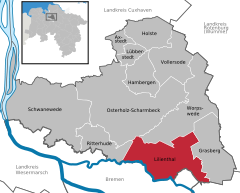Lilienthal, Lower Saxony
| Lilienthal | ||
|---|---|---|
|
||
| Coordinates: 53°8′N 08°55′E / 53.133°N 8.917°ECoordinates: 53°8′N 08°55′E / 53.133°N 8.917°E | ||
| Country | Germany | |
| State | Lower Saxony | |
| District | Osterholz | |
| Government | ||
| • Mayor | Willy Hollatz (Greens) | |
| Area | ||
| • Total | 72.03 km2 (27.81 sq mi) | |
| Elevation | 0 - 12 m (−39 ft) | |
| Population (2015-12-31) | ||
| • Total | 18,819 | |
| • Density | 260/km2 (680/sq mi) | |
| Time zone | CET/CEST (UTC+1/+2) | |
| Postal codes | 28865 | |
| Dialling codes | 04298 | |
| Vehicle registration | OHZ | |
| Website | www.lilienthal.de | |
The municipality of Lilienthal belongs to the administrative district of Osterholz, Lower Saxony and borders Bremen (Free Hanseatic City of Bremen).
Lilienthal belonged to the Prince-Archbishopric of Bremen.
The history of the small town (without Town privileges) of Lilienthal goes back to its founding as a nunnery by the prince-archbishop Gerhard II. In 1232 construction was begun on a convent of the Order of the Cistercians under the name of Vallis Liliorum (St. Mary's Nunnery in the Valley of Lilies), and the finished building was sanctified in 1264. During the 15th century, the cloister enjoyed a time of prosperity. After the Reformation and the conversion of the Cistercian nuns, it became a Lutheran Women's Convent, and until the end of the Thirty Years' War in 1648 it remained in deplorable conditions. In 1650, the city went through secularization. The land once belonging to the convent, which had become fragmented, developed into the small town of Lilienthal.
In 1648, according to the terms of the peace treaty that ended the Thirty Years' War (The Peace of Westphalia), the Prince-Archbishopric was transformed into the Duchy of Bremen, ruled together with the Principality of Verden, which were first ruled in personal union by the Swedish Crown. Queen Christina sent one of her commanders over, Graf Friedrich von Hessen-Eschwege, to the newly created barony (Herrschaft) of Osterholz, in which the charge of both Lilienthal and Osterholz were combined. After his early death in 1655, his wife Eleonora took over the government of the barony, with her seat in Osterholz, where she took an active role in the improvement of economic and sanitary conditions for the rural population. After her death in 1692, the barony fell back into the hands of the Swedish Royalty. Lilienthal remained a part of Swedish Bremen-Verden until 1712 (which is why the coat of arms contains the blue and yellow of the Swedish Flag), at which time it came under Danish occupation, and then in 1719 it fell under the sovereignty of the Electorate of Brunswick and Lunenburg (colloquially Electorate of Hanover), which ruled Bremen-Verden in personal union.
...
Wikipedia




